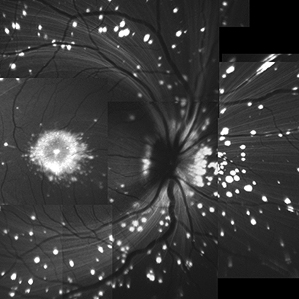Virus That Evolved in the Lab Delivers Gene Therapy into the Retina
A new delivery mechanism shuttles gene therapy deep into the eye’s retina to repair damaged light-sensing cells without requiring a surgeon to put a needle through this delicate tissue. The approach could make it substantially easier to treat inherited forms of eye disease with this approach.

Although still largely experimental, gene therapy is gradually moving to the hospital. The technology is involved in some 2,000 completed and ongoing clinical trials, and last December the European Union approved a gene therapy treatment for a metabolic disorder (see “Gene Therapy on the Mend as Treatment Gets Western Approval”). But until recently, most gene therapy has involved using naturally occurring viruses to deliver a genetic payload, says David Schaffer, a biomedical engineer at the University of California, Berkeley, and a 2002 MIT Technology Review Innovator Under 35, who was involved in the work. These viruses “have evolved to succeed in a natural setting, and we are using them to do something completely different,” he says.
The naturally occurring viruses that have been used to deliver therapy to the eye must be injected directly into the damaged retina, which can cause additional damage by detaching light-detecting photoreceptors from their supporting layer. To build a better system, Schaffer and colleagues turned to what’s known as directed evolution. The researchers produced millions of random variations of the adeno-associated virus, a harmless virus often used as a vector for gene therapy. From this vast pool, they ultimately identified the single strain that was the best at delivering new genes into damaged retinas. The work is published today in the journal Science Translational Medicine.
Working with mice that had two different genetic forms of retinal disease, the Berkeley researchers injected the millions of viruses into the fluid that fills the main body of the eye. From this fluid, naturally occurring adeno-associated viruses cannot reach the light-sensing cells of the retina because they get caught up on other surrounding cells. But by removing the rodent retinas and examining them, the team was able to identify strains that with mutations that enabled them to reach the critical tissue. Repeating the process led them to the strain that was most successful at reaching mouse photoreceptors.
In one of the conditions the group studied, called X-linked retinoschisis, a bad copy of a gene that makes a glue-like protein causes layers of the retina to rip apart, resulting in loss of vision. The experiments suggest that a working version of that gene, carried in the lab-identified virus, could potentially reverse that damage.
“The virus carried it across the whole retina, and as the retina glued itself back together, its response to light returned,” says John Flannery, a neurobiologist at the University of California, Berkeley, who was also involved with the work. The team also found that the viral vector was able to deliver a gene into the retina of a monkey, although not as effectively as in mice. The researchers are currently using directed evolution to find the best strain for delivering genes to primate retinas.
“Directed evolution now has been used by a number of groups, and it’s turning out to be a very robust way to find vectors that have novel properties that could be useful in gene-therapy settings,” says Mark Kay, director of the Human Gene Therapy program at Stanford University School of Medicine. The technique has already been used to identify engineered viruses that can better deliver gene therapies to the heart and other tissues, says Kay, and it’s likely to become more widely used in the future.
The next big hurdle, Kay adds, will be to test these DNA-delivering viruses in patients. “Lab animal results don’t always replicate in humans, even when using close species,” he says.
Keep Reading
Most Popular
Large language models can do jaw-dropping things. But nobody knows exactly why.
And that's a problem. Figuring it out is one of the biggest scientific puzzles of our time and a crucial step towards controlling more powerful future models.
How scientists traced a mysterious covid case back to six toilets
When wastewater surveillance turns into a hunt for a single infected individual, the ethics get tricky.
The problem with plug-in hybrids? Their drivers.
Plug-in hybrids are often sold as a transition to EVs, but new data from Europe shows we’re still underestimating the emissions they produce.
Stay connected
Get the latest updates from
MIT Technology Review
Discover special offers, top stories, upcoming events, and more.